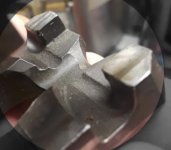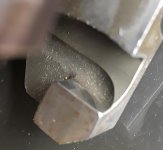How to install the app on iOS
Follow along with the video below to see how to install our site as a web app on your home screen.
Note: This feature may not be available in some browsers.
You are using an out of date browser. It may not display this or other websites correctly.
You should upgrade or use an alternative browser.
You should upgrade or use an alternative browser.
How would you machine this?
- Thread starter mteiken
- Start date
- Replies 13
- Views 2,676
wesg
Titanium
- Joined
- Nov 4, 2004
Looks fairly straight forward. But I'm not the one holding the part.
I'm guessing you're after what looks like a curved face in there, that's not millable?
In ascending order of likelyhood:
3d printed
EDM'd
5 axis milled
Klaus's hammer and chisel
Special built machine. Possibly a shaper of some sort.
I'm guessing you're after what looks like a curved face in there, that's not millable?
In ascending order of likelyhood:
3d printed
EDM'd
5 axis milled
Klaus's hammer and chisel
Special built machine. Possibly a shaper of some sort.
Looks fairly straight forward. But I'm not the one holding the part.
I'm guessing you're after what looks like a curved face in there, that's not millable?
In ascending order of likelyhood:
3d printed
EDM'd
5 axis milled
Klaus's hammer and chisel
Special built machine. Possibly a shaper of some sort.
Hm for something built in the 40s I think a couple of those didn’t exist and others not plausible. Was probably done with a special cutter on a jig in a conventional milling machine
tobydbaker74
Aluminum
- Joined
- Sep 8, 2018
- Location
- Columbus
We have a faro scanner for parts like that. Scan it make a mesh file and either 3d print it or load it into fusion 360 or some other cam system and machine the part with a ball nose. I may be missing something but doesn't look too difficult as long as you can machine in 3 axis.
Sent from my SM-G950U using Tapatalk
Sent from my SM-G950U using Tapatalk
That looks pretty straight forward from what I can see. I don't have a mg-42 handy for reference.
There were any number of profile machines capable of what we consider "complex" machining today. Many times it was a VERY simple setup, with custom cutters, on a dedicated machine for that operation. Remember these guns were made in masse, on specialized machines with specialized tooling, not on general purpose machines with general purpose tooling like most shops have today.
So to answer your question, I would do some research and see what historical data is available, I would solid model it, and set it up in my Brother and machine it. Problem is, they are super cheap... so other than curiosity...
You can't machine it 3 axis because the upper arm is blocking your access with a ball nose endmill.
This might help:
MG3 MG42 Barrel Extension, Trunnion, German Surplus, MGG-1768, RTG Parts
There were any number of profile machines capable of what we consider "complex" machining today. Many times it was a VERY simple setup, with custom cutters, on a dedicated machine for that operation. Remember these guns were made in masse, on specialized machines with specialized tooling, not on general purpose machines with general purpose tooling like most shops have today.
So to answer your question, I would do some research and see what historical data is available, I would solid model it, and set it up in my Brother and machine it. Problem is, they are super cheap... so other than curiosity...
and machine the part with a ball nose. I may be missing something but doesn't look too difficult as long as you can machine in 3 axis
You can't machine it 3 axis because the upper arm is blocking your access with a ball nose endmill.
This might help:
MG3 MG42 Barrel Extension, Trunnion, German Surplus, MGG-1768, RTG Parts
precisionmetal
Stainless
- Joined
- May 16, 2005
- Location
- CA
Difficult to get a clear mental picture of that (for me). Is a larger photo possible?
Since the polygon rifling through hammer-forging was developed in Germany, and the M42 was a "low-cost" weapon of the day, I'd be willing to bet that all (or at least most) of it was "formed". Stamped, punched, etc. Apparently 423,000 of these guns were made (and I suspect a *LOT* of extra barrels), so I'd seriously doubt if there was much machining going on.
PM
Since the polygon rifling through hammer-forging was developed in Germany, and the M42 was a "low-cost" weapon of the day, I'd be willing to bet that all (or at least most) of it was "formed". Stamped, punched, etc. Apparently 423,000 of these guns were made (and I suspect a *LOT* of extra barrels), so I'd seriously doubt if there was much machining going on.
PM
tobydbaker74
Aluminum
- Joined
- Sep 8, 2018
- Location
- Columbus
Ohh I think I was reading your post wrong. You dont need one just wondering how it was made?
Sent from my SM-G950U using Tapatalk
Sent from my SM-G950U using Tapatalk
Difficult to get a clear mental picture of that (for me). Is a larger photo possible?
Since the polygon rifling through hammer-forging was developed in Germany, and the M42 was a "low-cost" weapon of the day, I'd be willing to bet that all (or at least most) of it was "formed". Stamped, punched, etc. Apparently 423,000 of these guns were made (and I suspect a *LOT* of extra barrels), so I'd seriously doubt if there was much machining going on.
PM
You might be amazed how much machining Mauser was doing right up to USGI's rolling in the doors.
Mauser was a worldwide leader in nearly all metal working processes, from forging, stamping, metallurgy, machinery, cutters, heat treat, grinding. Even many wood processes for their stocks, lamination and glue were far beyond US and Allied capabilities.
Now it is true, that many of their forgings were, I believe the modern term is "near net", which meant VERY little machining was needed.
By 43/44 if I remember right, Mauser had transitioned to primarily focusing on anti air craft guns. The list of machines used for that contract is LONG and VERY impressive.
Here is one of FIFTEEN pages of machines dedicated to the 1940 contract for the Flak 38 produced by Mauser. These machines were not permitted to be used for anything but the contracted work.

(from Jon Speed's Collection)
mhajicek
Diamond
- Joined
- May 11, 2017
- Location
- Maple Grove, MN, USA
Not sure if the geometry works out, but from what I can see it looks like a full a radius slotting cutter from the end.
Spruewell
Hot Rolled
- Joined
- Sep 8, 2015
- Location
- Northern California
Horizontal mill with a special form cutter. Likely looked somewhat like a pelton wheel.
Rick Finsta
Stainless
- Joined
- Sep 27, 2017
Okay, all I got from this is Fal Grunt and I should probably have MG-42s.
Similar threads
- Replies
- 0
- Views
- 188




